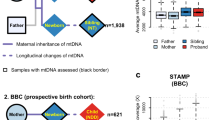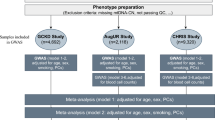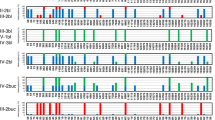Abstract
There is an increasing recognition of the potential role of variants in mitochondrial DNA and nuclear-encoded mitochondrial proteins in modifying disease risk. This has led to a rise in the number of mitochondrial association studies being undertaken. The unique inheritance pattern of mitochondria makes mitochondrial DNA variation susceptible to having geographical structure. Such a structure may have a dramatic impact on mitochondrial association studies, particularly in heterogeneous populations. By combining self-reported ancestry data and mitochondrial genotype data for a sample of 3839 individuals from 1037 Australian families, population substructure is tested by looking for evidence of differences in mitochondrial haplogroup and single nucleotide polymorphism (SNP) frequencies between different ancestral groups in Australia. In addition, the substructure within ancestral groups is tested by comparing the similarity of mates to randomly drawn pairs of individuals from the same ancestral group. It is shown that there are significant differences in the frequency of variants both between European and non-European groups, and within Europe. This agrees with previous studies of European mitochondrial variation. No evidence was found for structure within ancestral groups. These results have implications for future association studies in the Australian population, and other populations of heterogeneous ancestry.
Similar content being viewed by others
Log in or create a free account to read this content
Gain free access to this article, as well as selected content from this journal and more on nature.com
or
References
Wallace DC : A mitochondrial paradigm of metabolic and degenerative diseases, aging, and cancer: a dawn for evolutionary medicine. Annu Rev Genet 2005; 39: 359–407.
Mishmar D, Ruiz-Pesini E, Golic P et al: Natural selection shaped regional mtDNA variation in humans. Proc Natl Acad Sci USA 2003; 100: 171–176.
Ruiz-Pesini E, Mishmar D, Brandon M, Procaccio V, Wallace DC : Effects of purifying and adaptive selection on regional variation in human mtDNA. Science 2004; 303: 223–226.
Ingman M, Gyllensten U : Rate variation between mitochondrial domains and adaptive evolution in humans. Hum Mol Genet 2007; 16: 2281–2287.
Richards M, Macaulay V, Torroni A, Bandelt HJ : In search of geographical patterns in European mitochondrial DNA. Am J Hum Genet 2002; 71: 1168–1174.
Comas D, Calafell F, Mateu E, Perez-Lezaun A, Bosch E, Bertranpetit J : Mitochondrial DNA variation and the origin of Europeans. Hum Genet 1997; 99: 443–449.
McEvoy B, Richards M, Forster P, Bradley DG : The longue duree of genetic ancestry: multiple genetic marker systems and Celtic origins on the Atlantic façade of Europe. Am J Hum Genet 2004; 75: 693–702.
Pereira L, Goncalves J, Goios A, Rocha T, Amorim A : Human mtDNA haplogroups and reduced male fertility: real association or hidden population substructuring. Int J Androl 2005; 28: 241–247.
Feder J, Ovadia O, Glaser B, Mishmar D : Ashkenazi Jewish mtDNA haplogroup distribution varies among distinct subpopulations: lessons of population substructure in a closed group. Eur J Hum Genet 2007; 15: 498–500.
Hatt D, Parsons PA : Association between surnames and blood groups in the Australian population. Acta Genet 1965; 15: 309–318.
Devlin B, Roeder K : Genomic control for association studies. Biometrics 1999; 55: 997–1004.
Pritchard JK, Donnelly P : Case–control studies of association in structured or admixed populations. Theor Pop Biol 2001; 60: 227–237.
Marchini J, Cardon LR, Phillips MS, Donnelly P : The effects of human population structure on large genetic association studies. Nat Genet 2004; 36: 512–517.
The Wellcome Trust Case–Control Consortium: Genome-wide association study of 14,000 cases of seven common diseases and 3000 shared controls. Nature 2007; 447: 661–678.
Zhu G, Duffy DL, Eldridge A et al: A major quantitative-trait locus for mole density is linked to the familial melanoma gene CDKN2A:a maximum-likelihood combined linkage and association analysis in twins and their sibs. Am J Hum Gen 1999; 65: 483–492.
Wright MJ, Martin NG : Brisbane Adolescent Twin Study: outline of study methods and research projects. Aust J Psychol 2004; 56: 65–78.
McRae AF, Byrne EM, Zhao ZZ, Montgomery GW, Visscher PM : Power and SNP typing in whole-mitochondrial genome association studies. Genome Res 2008; 18: 911–917.
Zhu G, Montgomery GW, James MR et al: A genome-wide scan for naevus count: linkage to CDKN2A and to other chromosome regions. Eur J Hum Genet 2007; 15: 94–102.
Duffy DL, Montgomery GW, Chen W et al: A three-single-nucleotide polymorphism haplotype in intron 1 of OCA2 explains most human eye-color variation. Am J Hum Genet 2007; 80: 241–252.
Saxena R, de Bakker PI, Singer K et al: Comprehensive association testing of common mitochondrial DNA variation in metabolic disease. Am J Hum Genet 2006; 79: 54–61.
Zhao ZZ, Nyholt DR, Le L et al: KRAS variation and risk of endometriosis. Mol Hum Reprod 2006; 12: 671–676.
R Development Core Team: R: A language and Environment for Statistical Computing. Vienna, Austria: R Foundation for Statistical Computing, 2005; available at http://www.R-project.org.
Manwaring N, Jones MM, Wang JJ, Rochtchina E, Mitchell P, Sue CM : Prevalence of mitochondrial DNA haplogroups in an Australian population. Aust Int Med J 2006; 36: 530–533.
Fisher RA : On the interpretation of χ2 from contingency tables, and the calculation of P. J R Stat Soc 1922; 85: 87–94.
Schmidt TR, Wu W, Goodman M, Grossman LI : Evolution of nuclear- and mitochondrial-encoded subunit interaction in cytochrome c oxidase. Mol Biol Evol 2001; 18: 563–569.
Bayona-Bafaluy MP, Mueller S, Moraes CT : Fast adaptive coevolution of nuclear and mitochondrial subunits of ATP synthetase in orang-utan. Miol Biol Evol 2005; 22: 716–724.
Acknowledgements
We are grateful to the twins and their families for their generous participation in these studies. We thank Ann Eldridge and Marlene Grace for the collection of data and Megan Campbell and Anjali Henders for managing sample processing and preparation, and Brian McEvoy for helpful comments and suggestions. Financial support was provided by grants from the National Health and Medical Research Council (241944, 389875 and 389892). EB is supported by University of Queensland IPRS and UQILAS Awards, GWM and PMV are supported by NHMRC Research Fellowships and AFM is supported by NHMRC Postdoctoral Fellowship no. 496719.
Author information
Authors and Affiliations
Corresponding author
Rights and permissions
About this article
Cite this article
Byrne, E., McRae, A., Zhao, ZZ. et al. The use of common mitochondrial variants to detect and characterise population structure in the Australian population: implications for genome-wide association studies. Eur J Hum Genet 16, 1396–1403 (2008). https://doi.org/10.1038/ejhg.2008.117
Received:
Revised:
Accepted:
Published:
Issue date:
DOI: https://doi.org/10.1038/ejhg.2008.117



